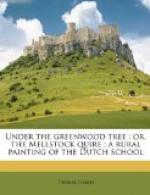“All the choir?” said the astonished vicar (who may be shortly described as a good-looking young man with courageous eyes, timid mouth, and neutral nose), abandoning his writing and looking at his parlour-maid after speaking, like a man who fancied he had seen her face before but couldn’t recollect where.
“And they looks very firm, and Tranter Dewy do turn neither to the right hand nor to the left, but stares quite straight and solemn with his mind made up!”
“O, all the choir,” repeated the vicar to himself, trying by that simple device to trot out his thoughts on what the choir could come for.
“Yes; every man-jack of ’em, as I be alive!” (The parlour-maid was rather local in manner, having in fact been raised in the same village.) “Really, sir, ’tis thoughted by many in town and country that—”
“Town and country!—Heavens, I had no idea that I was public property in this way!” said the vicar, his face acquiring a hue somewhere between that of the rose and the peony. “Well, ’It is thought in town and country that—’”
“It is thought that you be going to get it hot and strong!—excusen my incivility, sir.”
The vicar suddenly recalled to his recollection that he had long ago settled it to be decidedly a mistake to encourage his servant Jane in giving personal opinions. The servant Jane saw by the vicar’s face that he recalled this fact to his mind; and removing her forehead from the edge of the door, and rubbing away the indent that edge had made, vanished into the passage as Mr. Maybold remarked, “Show them in, Jane.”
A few minutes later a shuffling and jostling (reduced to as refined a form as was compatible with the nature of shuffles and jostles) was heard in the passage; then an earnest and prolonged wiping of shoes, conveying the notion that volumes of mud had to be removed; but the roads being so clean that not a particle of dirt appeared on the choir’s boots (those of all the elder members being newly oiled, and Dick’s brightly polished), this wiping might have been set down simply as a desire to show that respectable men had no wish to take a mean advantage of clean roads for curtailing proper ceremonies. Next there came a powerful whisper from the same quarter:-
“Now stand stock-still there, my sonnies, one and all! And don’t make no noise; and keep your backs close to the wall, that company may pass in and out easy if they want to without squeezing through ye: and we two are enough to go in.” . . . The voice was the tranter’s.
“I wish I could go in too and see the sight!” said a reedy voice—that of Leaf.
“’Tis a pity Leaf is so terrible silly, or else he might,” said another.
“I never in my life seed a quire go into a study to have it out about the playing and singing,” pleaded Leaf; “and I should like to see it just once!”
“Very well; we’ll let en come in,” said the tranter. “You’ll be like chips in porridge, {1} Leaf—neither good nor hurt. All right, my sonny, come along;” and immediately himself, old William, and Leaf appeared in the room.




